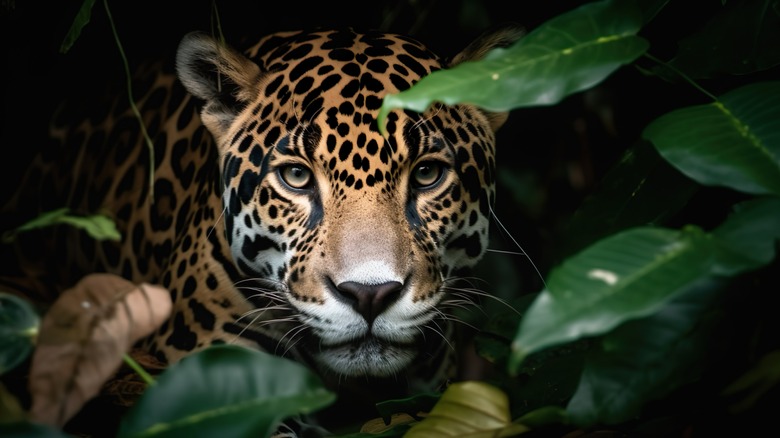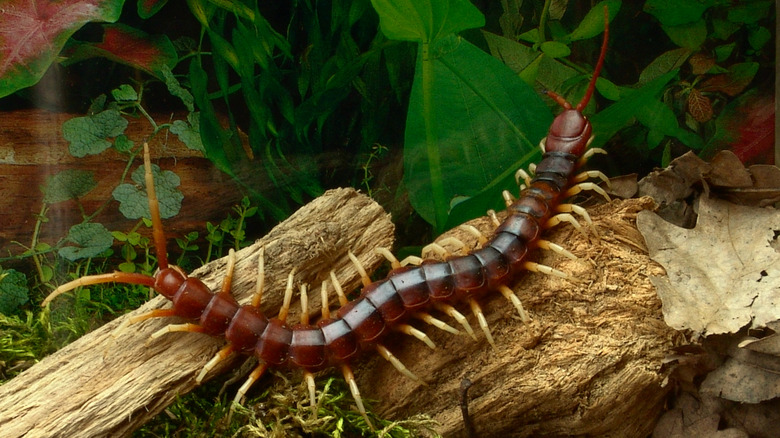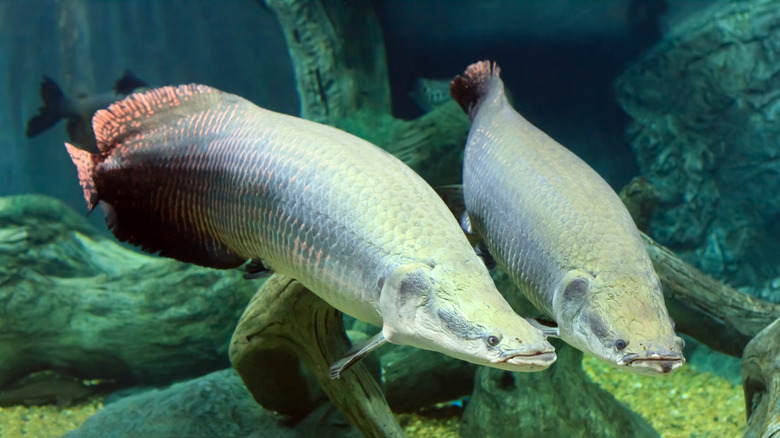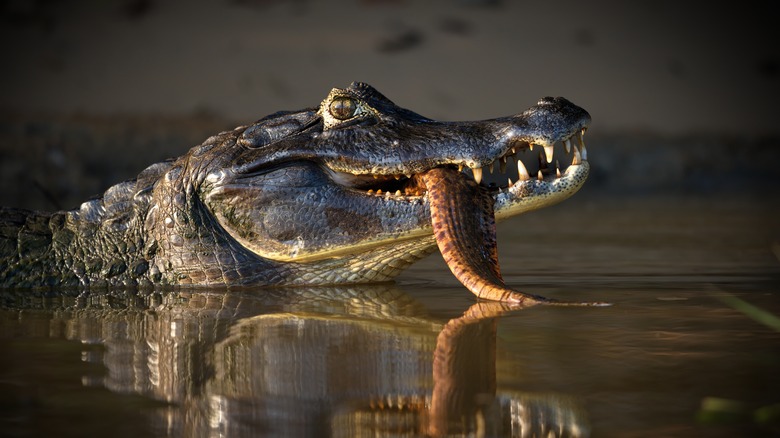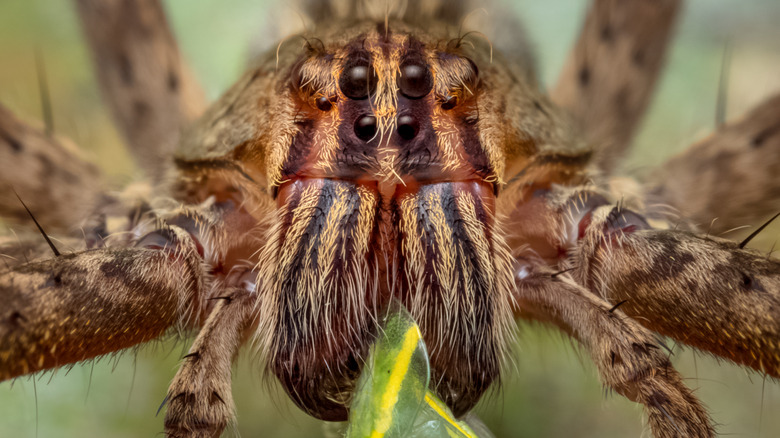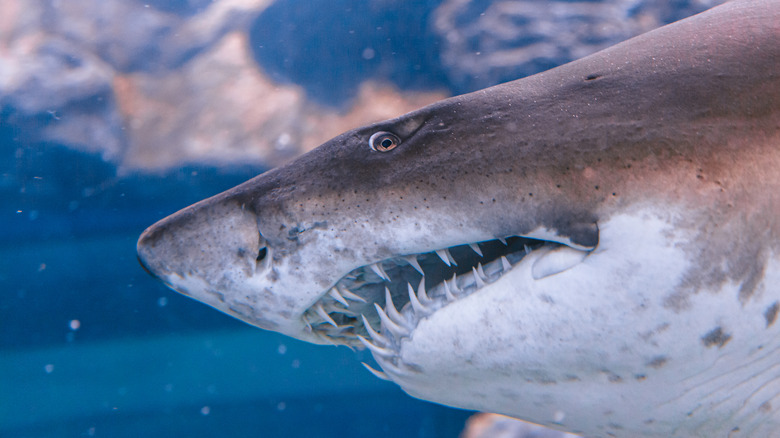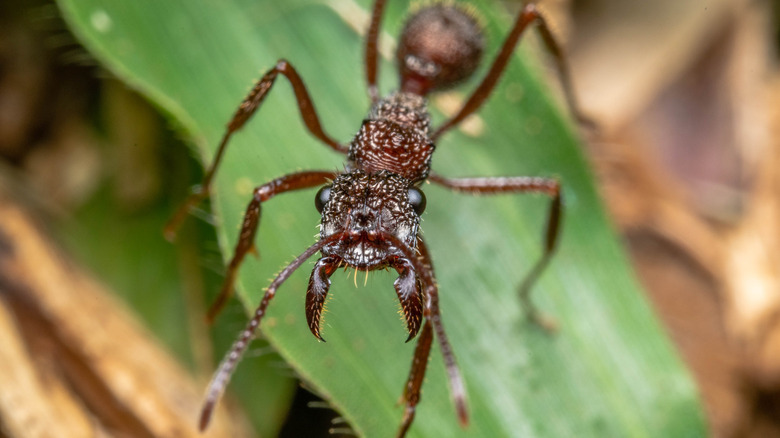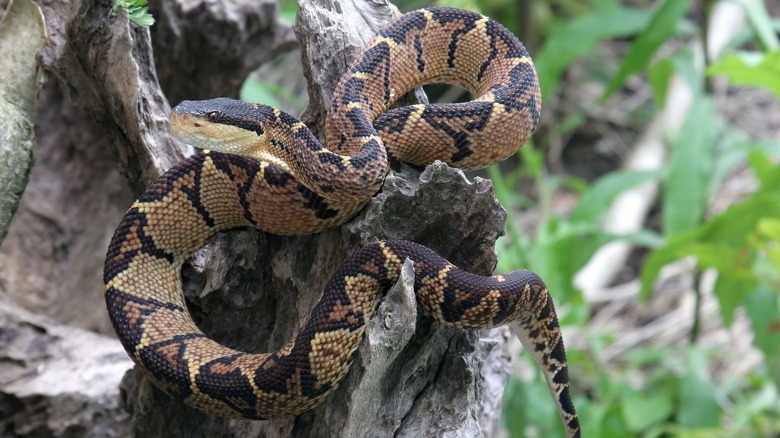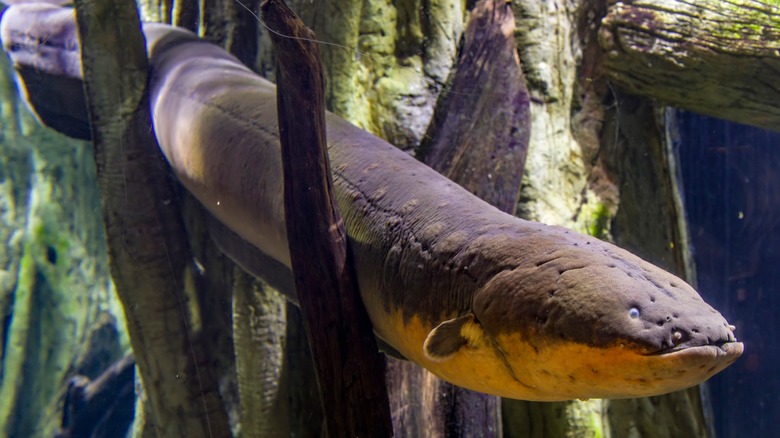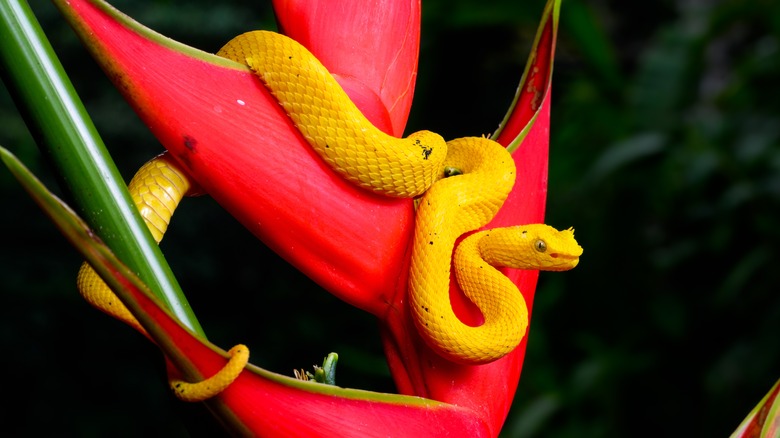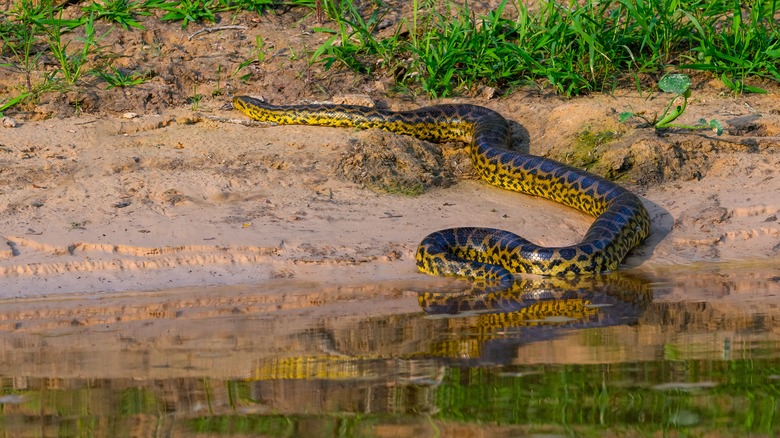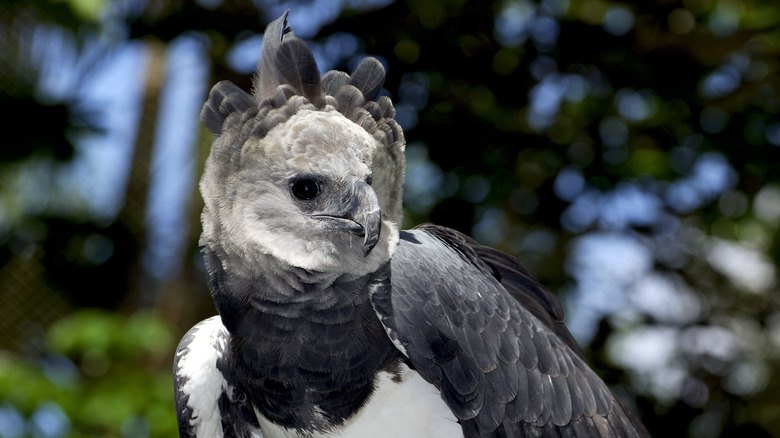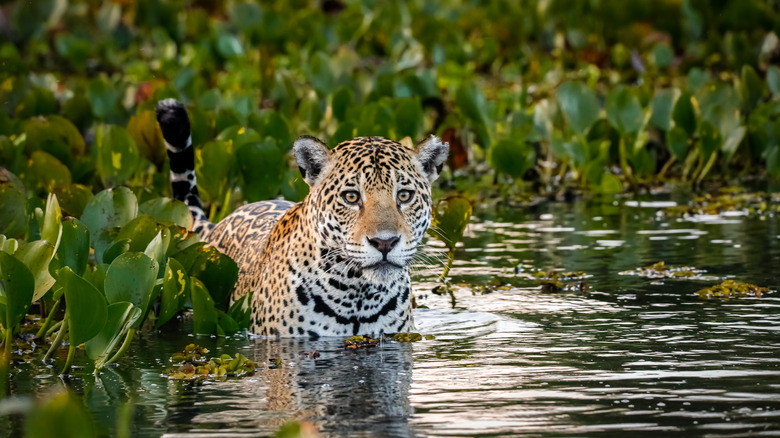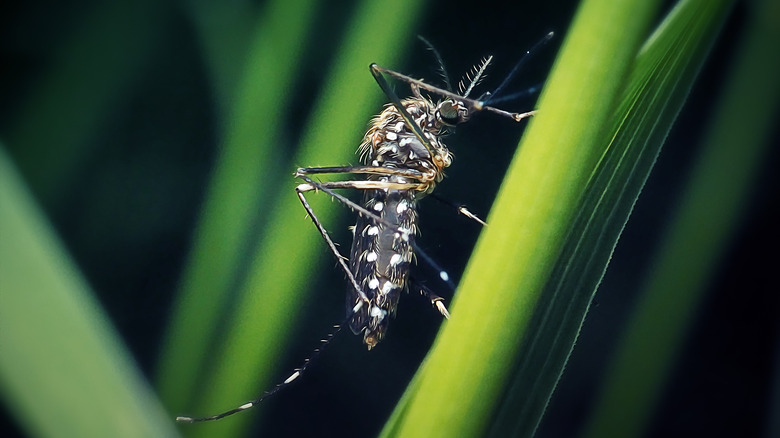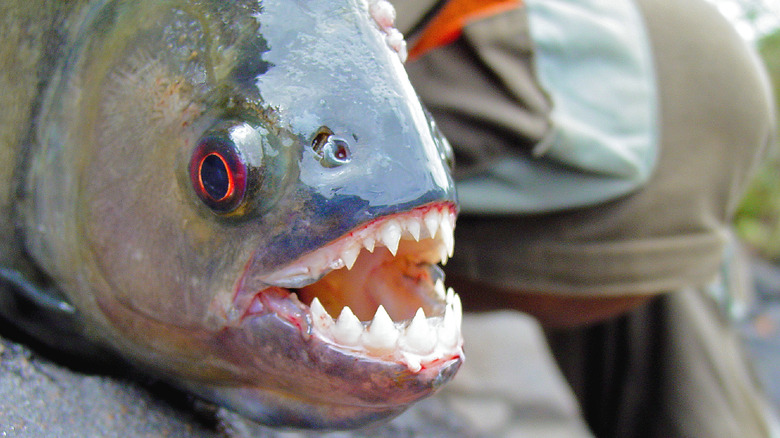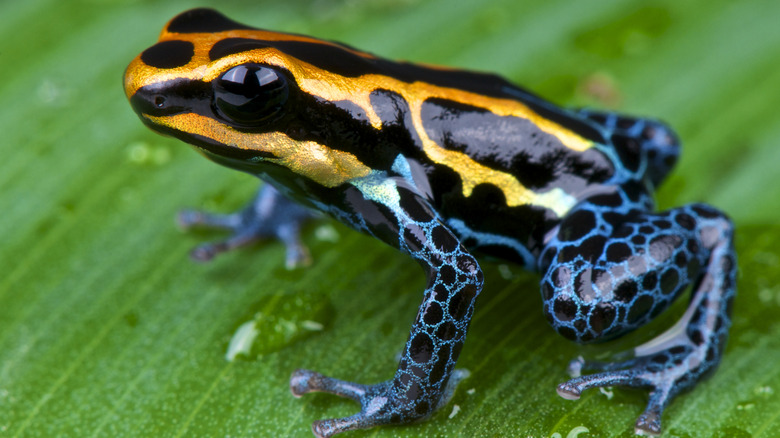The Most Dangerous Animals In The Amazon Rainforest
Spanning 4.1 million square miles, the Amazon is a massive biome that is home to the largest tropical rainforest in the world. It contains vast swathes of forests and a network of winding rivers. It's also the most biodiverse place on the planet. Hidden underneath the jungle canopy and within its waters are some pretty amazing creatures. It's one of the best places to spot rare wildlife up close. However, there are several animals in the Amazon that you definitely don't want to come face-to-face with.
Millions of species call the Amazon rainforest home, including mammals, reptiles, fish, birds, and insects. Many of these creatures have adapted to survive in the harsh jungle environment, and some of those adaptations make the animals downright deadly. Think lethal venom, jagged teeth, and sharp talons. If you're planning a trip to this spectacular rainforest, these are some of the most dangerous animals in the Amazon that you'll want to keep an eye out for and steer clear of.
Amazonian Giant Centipede
The Amazonian giant centipede is the largest centipede in the world, with some growing up to 12 inches. These carnivorous creatures use their brute strength and potent venom to prey on animals like frogs, tarantulas, and mice. Some have even been known to scale cave walls to hunt bats. They like to hang out in dark, damp places like under leaves, in caves, and inside rotting wood.
While a bite from a giant centipede would probably be very painful, it's unlikely you would die from the venom. That being said, there has been one confirmed death from a giant centipede. According to an El Tiempo article from 2014, a 4-year-old boy in Venezuela died after being bitten by a giant centipede that was in a soda can. Although scientists who studied the specimen agreed that it was indeed a giant centipede, they reported that it was the first case they knew of where one had caused a human fatality. Still, it's something to keep in mind while you're trekking through the rainforest.
Arapaima
The mighty arapaima is a freshwater fish that can grow up to 12 feet and weigh over 400 pounds. It typically cruises the rivers of the Amazon Basin, but as an air-breathing fish, it can also survive out of water for up to 24 hours. You probably don't want to see this fierce predator coming at you, as they can move lightning fast and have sharp, hard teeth that can rip their prey to shreds.
Also called pirarucu, these sizable fish live in slow-moving rivers. They have been known to leap out of the water to attack anglers. The good news is they don't typically eat humans. They usually only attack people if they feel threatened. In addition, they can be easy to spot. Arapaimas need to come to the surface of the water to breathe, so you may see them coming up for air. When they surface, they often make a distinctive loud gulping sound, so it's possible that you hear them before you see them.
Black Caiman
The black caiman is the biggest predator in the Amazon rainforest, weighing in at about 800 pounds and reaching lengths of up to 16 feet. Caimans are related to alligators, and have similar traits like powerful jaws and sharp teeth. They'll eat pretty much anything, including fish, birds, and mammals. If given the chance, they will also attack humans.
Be very wary when hanging out by rivers, lakes, and flooded areas in the Amazon Basin because you could be in black caiman territory. You might see the animals basking on the riverbanks. Then again, they could be lurking just under the surface of the water. Their black scales make it difficult to see them if they're in the water, especially at night. Black caimans are adept at sudden attacks and have been known to attack fishermen retrieving nets. In 2010, an 11-year-old boy was attacked and killed by a black caiman while swimming in a channel in the Brazilian Amazon.
Brazilian Wandering Spider
Also known as the banana spider or armed spider, the Brazilian wandering spider is one of the most dangerous bugs in the world thanks to its highly toxic venom. There are nine species of Brazilian wandering spider, most of which have brown or gray hairy bodies. They can grow up to two inches with a leg span of about seven inches. They're called wandering spiders because instead of making webs, they prowl the ground at night hunting for prey. The spiders use their venom to paralyze prey like insects, mice, and lizards.
Brazilian wandering spiders usually only bite humans if they are provoked. A bite from one of these critters can be incredibly painful. If you get bitten by one, you may need medical attention, as the bites can cause high blood pressure, convulsions, and hypothermia. Interestingly, they can also cause prolonged and painful erections. Although few people have died from a wandering spider bite, it's a possibility. According to a report in Clinical Toxinology in Australia, Europe, and Americas, there have been 15 deaths attributed to Brazilian wandering spider bites (in Brazil) since 1903.
Bull Shark
One of the strange, but true things you might not know about the Amazon rainforest is that there are sharks in the Amazon River. Bull sharks are an oddity in the shark world, as they can live in saltwater and freshwater environments. These aggressive apex predators have been known to make their way from the Atlantic Ocean up the Amazon River. In fact, some have been found as far as 2,500 miles inland.
Bull sharks will eat pretty much anything they can sink their teeth into, including humans. They're not afraid to attack larger prey, which makes them particularly dangerous. The majority of bull sharks in the Amazon River are found in the Brazilian Amazon because this is where the river feeds into the Atlantic Ocean. Avoid swimming in murky waters, as this is where they often hunt. The further inland you go, the less likely you are to run into a bull shark in the river. However, it's best not to take any chances.
Bullet Ant
Bullet ants may be small, but they can unleash a world of pain. The insects have neurotoxic peptides in their venom that cause extreme pain when they sting. Some people describe it as a searing, throbbing pain that can last up to 24 hours. Entomologist Justin Schmidt gave the bullet ant sting the second-highest rating on his sting pain index. According to the Natural History Museum, he described the pain as, "Pure, intense, brilliant pain. Like walking over flaming charcoal with a 3-inch nail in your heel."
Bullet ants are reddish-brown ants that typically build their colonies at the base of trees. The worker ants can be found scavenging on the forest floor and in the canopy. They use their venomous sting to attack prey and to defend themselves. Be careful where you step in the jungle, because you may find yourself with a nasty bite. The good news is one bite from a bullet ant won't kill you. However, you just might wish it did.
Bushmaster Snake
Measuring roughly six feet long, bushmaster snakes are the longest venomous snakes in the Americas. They're also considered some of the most dangerous snakes in the world because of their powerful venom. A bite from a bushmaster can cause blistering, necrosis, low blood pressure, and respiratory failure. In some cases, the venom has caused death in less than an hour. Bushmasters are fast strikers and tend to eject large amounts of venom. They typically use their venom on prey like rodents, frogs, and birds, but will attack humans if provoked.
Bushmasters often have distinctive diamond or X-shaped markings and they range in color from deep brown to muted pink or gray. They like to hide under rocks and logs or in vegetation and wait for prey to pass by. The good news is they're not very aggressive and tend to shy away from humans. Like any wild animal though, you can never predict how one will act if you cross its path. It's best to stay far away from these highly poisonous pit vipers.
Electric Eel
Electric eels are another reason why the waterways in the Amazon are some of the world's most dangerous places to swim. These unique creatures are actually fish with the ability to release electric charges up to 860 volts. The electric pulses are used to navigate, communicate, stun prey, and ward off predators. They're interesting animals to watch, but you don't want to touch one. A shock from an electric eel can knock you off your feet, and even cause respiratory or heart failure.
Electric eels can be found in slow-moving channels in the Amazon Basin, as well as lakes, pools, and flooded areas. They are nocturnal animals, so most active at night. They prefer murky waters, which can make it difficult to see their brown or gray, snake-like bodies amid the mud. If you want to avoid an accidental encounter with an electric eel, don't go wading in shallow, muddy water in the Amazon.
Eyelash Viper
The warm, humid environment in the Amazon rainforest is ideal for the eyelash viper. This tropical pit viper likes to hide in bushes, vines, and foliage waiting to ambush prey like lizards, frogs, and small mammals. Reaching lengths of about 32 inches, they're not particularly big snakes but can be dangerous for humans. The eyelash viper's venom is hemotoxic, meaning it attacks the circulatory system. A bite can cause swelling, pain, necrosis, and even death. Fortunately, eyelash vipers don't usually bite humans unless defending themselves, and most bites only cause mild symptoms.
Eyelash vipers can be tricky to identify because they come in a range of colors, from bright yellow to green, red, turquoise, and brown. Their defining features are the large scales above their eyes that look like eyelashes. They spend most of their time above ground in trees and bushes and are most active at night. The majority of bites happen when people step on them or purposely harass them.
Green Anaconda
If you watched any of the "Anaconda" movies, the name of this snake might send shivers down your spine. While the movies were wildly OTT, they did get a few things right. For one, the anaconda is the heaviest snake in the world, with some weighing over 500 pounds. Secondly, they like to live near water where they can lie in wait for their prey, which includes deer, wild pigs, and capybara. And yes — they do squeeze their prey to death and swallow it whole.
When you consider that anacondas have been known to go after large, dangerous prey like caimans and jaguars, it's not a stretch to think they would attack a human. However, this is actually very rare. As zoologist Georgia Mills told The Naked Scientists, "Firstly the anaconda is not going to want to eat you, most likely. Humans are just a bit too big for them. There's not many cases of an anaconda actually going for a human — I think most of the cases are anaconda researchers getting a bit too cheeky and getting snapped at. But they have been documented for going for children and very small humans."
Harpy Eagle
Named after the harpy from Greek mythology (a half-human, half-bird creature), harpy eagles are some of the biggest and most powerful birds of prey. They are distinctive for their unique feathers that fan out from the top of their heads and create a round facial disc. These majestic animals have wingspans of up to six and a half feet. Their powerful legs and large talons can scoop up monkeys, iguanas, and sloths, which they can tear apart with their hooked beaks.
While harpy eagles are savvy predators that can carry off large prey, it's highly unlikely that you would be attacked by one. That is, unless you intrude on their territory. According to The Guardian, a female harpy eagle in Venezuela viciously attacked several BBC filmmakers when they tried to set up cameras in the bird's nest. Video footage shows the eagle swooping several times straight for cameraman James Aldred's face. He survived, but the raptor hit him hard enough to stun him and knock off his microphone.
Jaguar
Many of the animals on this list are the biggest of their kind, and the jaguar is no exception. This is the largest big cat in the Americas, and most of them are found in the Amazon rainforest. They can grow up to five and a half feet long and weigh in at about 260 pounds. They're adept at climbing, running, leaping, and swimming, and will eat pretty much anything they come across in the wild. Jaguars have been known to eat deer, monkeys, tapirs, and even caiman.
Many people will tell you that if you see a jaguar in the wild, it's already too late. These stealthy hunters like to stalk their prey like silent ninjas. Unlike other big cats that usually go straight for the jugular, jaguars often bite their victims in the back of the head, crushing the skull with their powerful jaws. It might be comforting to know that although there have been cases of jaguars attacking humans, it's an incredibly rare occurrence.
Mosquitos
The tiny mosquito may not seem like a formidable foe, but it's what they carry that can be so dangerous. Mosquitoes can transmit infectious diseases like malaria, yellow fever, chikungunya, dengue fever, and the Zika virus. These diseases can not only make you very sick, but some can be fatal. And some of them, like malaria, can stay in your system for years and cause relapses.
With its lush forests, humid conditions, and slow-moving waters, the Amazon rainforest is the perfect breeding ground for mosquitoes. If you're heading into the rainforest, be sure to bring mosquito repellant and cover up with a long-sleeved shirt and pants. Mosquitoes are most active early in the morning and late in the afternoon, so this is when you want to be most vigilant. You may want to invest in a good mosquito net. In addition, you may want to consider talking to your doctor about medications or vaccines you can get prior to traveling.
Piranha
When President Theodore Roosevelt visited the Brazilian Amazon in 1913, locals took him to a river full of hungry piranhas and threw a cow in the water to show him a fish-feeding frenzy. The president reported in his memoir "Through the Brazilian Wilderness," "They are the most ferocious fish in the world ... The razor-edged teeth are wedge-shaped like a shark's, and the jaw muscles possess great power. The rabid, furious snaps drive the teeth through flesh and bone. The head with its short muzzle, staring malignant eyes, and gaping, cruelly armed jaws, is the embodiment of evil ferocity; and the actions of the fish exactly match its looks."
President Roosevelt's description sparked a fear for piranhas that endures to this day, but the truth is they're not the human killers many believe them to be. There are 20 different species of piranhas in the Amazon River. While most are carnivorous and will attack smaller fish with their sharp, blade-like teeth, some are vegetarians. Piranhas have been known to attack humans, but it doesn't happen often. Steve Huskey, professor of biology at Western Kentucky University, told Live Science, "They could do tremendous damage to humans throughout South America, if they were so inclined, but they're not ... and they don't."
Poison Dart Frog
With their bright colors and glossy bodies, poison dart frogs sure are pretty. But as the name suggests, they're also extremely poisonous. The frogs secrete poison through their skin that can be lethal if it's absorbed into the body. The golden poison frog is the most poisonous species, with enough venom to kill 10 people. If you come across a poison dart frog in the wild, you definitely don't want to touch one of these amphibious creatures.
These tiny frogs typically only grow to about half an inch long. They like to live near water and hunt for small insects on the jungle floor. You'll likely be able to spot them from their bright colors which can include vibrant blue, green, red, and yellow. However, some may be camouflaged in the flowers and foliage. Their poison is a defense mechanism to make them distasteful to predators. The poison can cause nausea, swelling, and paralysis of the muscles. If it enters your bloodstream, it could be lethal. If you accidentally touch one, be sure to wash your hands immediately.
